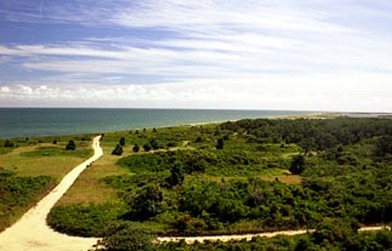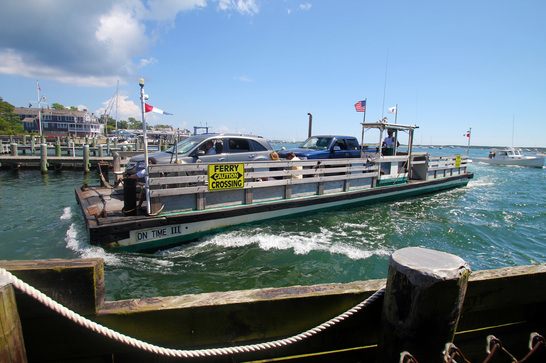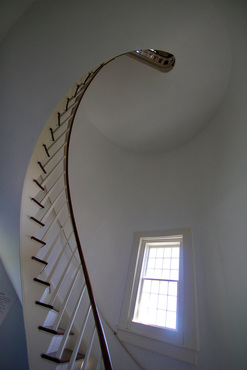History of Cape Poge Light, Chappaquiddick Island, Massachusetts
© Jeremy D'Entremont. Do not reproduce any part of this website without permission of the author.
Cape Poge (sometimes spelled "Pogue") is a lonely, windswept point at the northeast tip of Chappaquiddick, an island of about five square miles just east of Martha's Vineyard.

The two islands are connected at their southern ends by a narrow barrier beach, but most people get to Chappaquiddick by taking the tiny "On Time" ferry from Edgartown.
With Edgartown's whaling business flourishing at the dawn of the nineteenth century, Congress recognized the need for a navigational light at Cape Poge to help direct traffic to the town's harbor. An appropriation of $2,000 was made on January 30, 1801, and by early March, four acres of land had been purchased for a light station.
Right: Fishermen in Edgartown Harbor with Cape Poge in the distance.
With Edgartown's whaling business flourishing at the dawn of the nineteenth century, Congress recognized the need for a navigational light at Cape Poge to help direct traffic to the town's harbor. An appropriation of $2,000 was made on January 30, 1801, and by early March, four acres of land had been purchased for a light station.
Right: Fishermen in Edgartown Harbor with Cape Poge in the distance.
A 35-foot, octagonal wooden lighthouse tower was completed in November 1801. A small, two-room keeper's house was also built. A primitive "spider lamp" exhibited a fixed white light 55 feet above mean high water.

Circa 1859. (U.S. Coast Guard)
President Thomas Jefferson appointed Matthew Mayhew the first keeper at $200 a year. Mayhew and his wife had eight children, several of them born during their years at Cape Poge. It was a difficult and isolated place for a family to live. At first, Mayhew was not provided a boat. He requested one and was allowed to buy one in late 1802, provided it cost no more than $70.
In 1825, Mayhew reported the loss of two acres of land at the station due to erosion. The house was moved before the ocean could claim it. Mayhew died at 68 in 1834, and his successor couldn't reach the station for two weeks due to ice. During the period before a new keeper arrived, a schooner was wrecked at Cape Poge. Several passengers froze to death, including one who died after reaching the lighthouse. It isn't known if the light at Cape Poge was operating at the time of the wreck.
The tower was moved back from the edge of the eroding bluff in 1838. I.W.P. Lewis, who inspected the station in 1842, pulled no punches in his report:
An octagonal frame building, rotten from base to roof, and requires to be rebuilt at once; has been moved from its original position several hundred feet on account of the inroads of the sea. The keeper states that, four years since, a breakwater, (so called,) consisting of pilings, planks, and ballast, was constructed, to protect the point from further decay; but the whole was demolished the following winter, and its remains (the ballast) are now visible under water about seventy-five feet outside of the present beach.
Lewis also reported that the three-room keeper's dwelling was "rotten, leaky and unfit to repair." The keeper, Lott Norton, stated, "I am very much troubled to find sleeping room for my family... There is not a single closet in the house, nor any convenience, save the three rooms above mentioned." Keeper Norton was supplied with a boat, but complained "... she is old and rotten."
In 1825, Mayhew reported the loss of two acres of land at the station due to erosion. The house was moved before the ocean could claim it. Mayhew died at 68 in 1834, and his successor couldn't reach the station for two weeks due to ice. During the period before a new keeper arrived, a schooner was wrecked at Cape Poge. Several passengers froze to death, including one who died after reaching the lighthouse. It isn't known if the light at Cape Poge was operating at the time of the wreck.
The tower was moved back from the edge of the eroding bluff in 1838. I.W.P. Lewis, who inspected the station in 1842, pulled no punches in his report:
An octagonal frame building, rotten from base to roof, and requires to be rebuilt at once; has been moved from its original position several hundred feet on account of the inroads of the sea. The keeper states that, four years since, a breakwater, (so called,) consisting of pilings, planks, and ballast, was constructed, to protect the point from further decay; but the whole was demolished the following winter, and its remains (the ballast) are now visible under water about seventy-five feet outside of the present beach.
Lewis also reported that the three-room keeper's dwelling was "rotten, leaky and unfit to repair." The keeper, Lott Norton, stated, "I am very much troubled to find sleeping room for my family... There is not a single closet in the house, nor any convenience, save the three rooms above mentioned." Keeper Norton was supplied with a boat, but complained "... she is old and rotten."
Winslow Lewis completed a new tower, with new lighting equipment, in 1844 at a cost of $1,600.

1892 drawing of Cape Poge Light
A fourth-order Fresnel lens replaced the lamps and reflectors installed by Lewis in 1857, and a new lantern was installed on the tower at the same time.
In August 1856, while Daniel Smith was keeper, a 13-year-old girl was playing in a small boat on the beach at Cape Poge when the tide carried the boat into the ocean. Joshua Smith, the 11-year-old son of the keeper, saw the girl and fetched help.
In August 1856, while Daniel Smith was keeper, a 13-year-old girl was playing in a small boat on the beach at Cape Poge when the tide carried the boat into the ocean. Joshua Smith, the 11-year-old son of the keeper, saw the girl and fetched help.
The boy and others went out in a boat and rescued the girl, whose boat was filling with water and would have sunk. Her father subsequently published a note of thanks to his daughter's rescuers in the Vineyard Gazette.

In 1878, it was reported that the keeper's house would probably "fall into the sea within two years." A new, larger dwelling was built, farther from the shore, in 1880. The bigger house was needed largely because the station was assigned an assistant keeper in 1867.
A wooden tower, 40 feet inland from the previous one, was built in 1893. At the time it was considered a temporary structure, but it has survived to this day.
In 1911, the apparatus that turned the lens malfunctioned, and the keepers had to turn the lens by hand for four nights until new bearings finally arrived.
The 1893 tower has been moved four times, the first time in 1907. It was moved 95 feet inland in 1922; in 1960 it was moved back another 150 feet.
A wooden tower, 40 feet inland from the previous one, was built in 1893. At the time it was considered a temporary structure, but it has survived to this day.
In 1911, the apparatus that turned the lens malfunctioned, and the keepers had to turn the lens by hand for four nights until new bearings finally arrived.
The 1893 tower has been moved four times, the first time in 1907. It was moved 95 feet inland in 1922; in 1960 it was moved back another 150 feet.
On rare occasions the harbor between Edgartown and Cape Poge has been frozen over in winter. Vineyard Gazette editor Henry Beetle Hough recorded walking over the ice to Cape Poge during a stretch of severe cold in 1933.

A 1934 article reported that Keeper Marcus Pieffer made trips to Edgartown twice weekly for supplies. He had to travel the length of Chappaquiddick Island to get to the ferry that took him to Edgartown. During the winter he used a motorboat and made the trip by water.
The light was automated in 1943 and the last keeper, Joseph Dubois, was removed. In 1954 the keeper's house was sold to a private party. It was torn down for the lumber.
The tower had to be moved back about 500 feet from the eroding shoreline in 1987. The lighthouse was moved by a U.S. Army helicopter, and the lantern was moved separately. The workers found that the tower's windows had been broken and birds had taken up residence inside the lighthouse. Some refurbishing of the tower was done in the new location.
The light was automated in 1943 and the last keeper, Joseph Dubois, was removed. In 1954 the keeper's house was sold to a private party. It was torn down for the lumber.
The tower had to be moved back about 500 feet from the eroding shoreline in 1987. The lighthouse was moved by a U.S. Army helicopter, and the lantern was moved separately. The workers found that the tower's windows had been broken and birds had taken up residence inside the lighthouse. Some refurbishing of the tower was done in the new location.
In October 1997, the lantern was removed from the tower by helicopter. It was taken to Falmouth and then trucked to New Bedford, where it was sandblasted and repainted, and broken panes of glass were replaced.

David F. Belcher, superintendent of the Chappaquiddick management unit of the Trustees of Reservations, was in charge of the renovations. "I'm determined to bring it back to that [1893] look," Belcher told the Cape Cod Times. Despite its remoteness, Belcher said that thousands of visitors view Cape Poge Light each year.
Left: The wooden stairway inside Cape Poge Light has been beautifully restored.
Cape Poge Light continues to serve as an active aid to navigation. The lighthouse can be reached via a 3.5-mile hike from the Dike Bridge or with the use of a four-wheel drive vehicle; you must obtain a permit. The route may be closed at times due to erosion.
Left: The wooden stairway inside Cape Poge Light has been beautifully restored.
Cape Poge Light continues to serve as an active aid to navigation. The lighthouse can be reached via a 3.5-mile hike from the Dike Bridge or with the use of a four-wheel drive vehicle; you must obtain a permit. The route may be closed at times due to erosion.
The lighthouse can also be visited on an excellent tour offered in season by the Trustees of Reservations.

A view from the top
Keepers: (This list is a work in progress. If you have any information on the keepers of this lighthouse, I'd love to hear from you. You can email me at [email protected]. Anyone copying this list onto another web site does so at their own risk, as the list is always subject to updates and corrections.)
Matthew Mayhew (1801-1834); Lot [Lott?] Norton (1835-1844); Aaron Norton (1844-1850); Edward Worth (1850-1853); Daniel Smith (1853-1859); George Ripley Marchant (1859-1866); Edward Worth (1866-1882); Jethro Worth (assistant 1867-1882, principal keeper 1882-1883); George H. Fisher (1883-1898); George H. Dolby (1898-1902); Wallace Eldredge (1902-1908); J. E. Barrus (1908-1919); Henry L. Thomas (1919-1931); Marcus Pieffer (1931-1938); Joseph H. Dubois (1938-1943).
Matthew Mayhew (1801-1834); Lot [Lott?] Norton (1835-1844); Aaron Norton (1844-1850); Edward Worth (1850-1853); Daniel Smith (1853-1859); George Ripley Marchant (1859-1866); Edward Worth (1866-1882); Jethro Worth (assistant 1867-1882, principal keeper 1882-1883); George H. Fisher (1883-1898); George H. Dolby (1898-1902); Wallace Eldredge (1902-1908); J. E. Barrus (1908-1919); Henry L. Thomas (1919-1931); Marcus Pieffer (1931-1938); Joseph H. Dubois (1938-1943).


